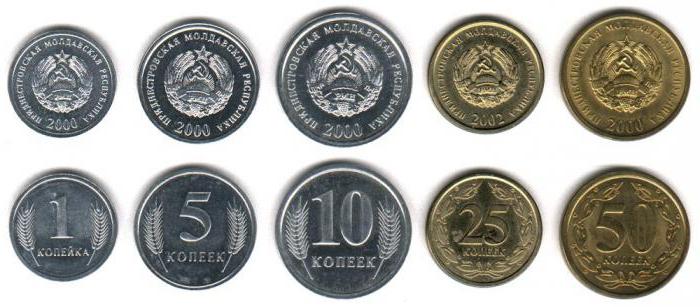Those who are interested in the banknotes of different countries should be quite interested in the coins of Transnistria. Their appearance and all kinds of changes are associated with different stages of development of the state itself.
Self currency
The Dnieper Moldavian Republic was formed in the nineties of the last century. For a long time, it was not recognized as an independent state. Nevertheless, a few years after the collapse of the Union, new Transnistrian rubles were introduced there, which in comparison with old Soviet money had a ratio of 1: 1000. The first coins of Transnistria appeared in circulation only in 2000. They were denominations of 1, 5, 10, 25 and 50 kopecks.

The smallest of them (1, 5 and 10) were made of aluminum alloy and consisted of round billets of different diameters from 16 to 20 millimeters with a smooth edge and coat of arms on the obverse, around which the name of the state and year of manufacture were placed around the circumference. On the reverse there were numbers denoting the face value, the word "cents", and on the sides - two modest spikelets. The remaining coins of Transnistria (25 and 50) looked somewhat different. In 2002, an alloy of zinc and copper was already used for their manufacture. In diameter, they were respectively 17 and 19 millimeters. The obverse was almost unchanged, with the exception of the year of manufacture, and on the reverse, the spikelets were replaced by floral ornaments. In 2005, the country opened its own mint. There is no need to place orders for coinage abroad. Transnistria's coins began to be produced domestically. From this moment begins their story.
Tribute to the memory
Then, in 2000, the first commemorative coins of Transnistria first appeared in circulation. There were several of them:
- 25 and 50 rubles in four decades of the creation of PMR, made of copper and nickel.
- The same denomination made of silver and gold.
Later, in 2015, new instances appeared:
- 1 ruble in honor of 25 years of the founding of the state - made of nickel-plated steel.
- 25 rubles of the same subject in the form of a steel disk with a brass ring.
- Two options for 1 ruble: in honor of 70 years of Victory and with its graphic image. In addition, there was also the “Year of the Monkey” and the “Memorial of Glory”.
Prior to this, in 2014 a series was released dedicated to the main cities of the country (Tiraspol, Bender, Rybnitsa, Dubossary, Slobodzeya, Grigoriopol, Dniester and Kamenka). Then, in 2016, the same ruble came out in different versions with the zodiac signs on the obverse. The collection was very popular among citizens. Separately, one can consider a series devoted to the Orthodox churches of Transnistria. It was released in 2014-2015. All copies came out in approximately the same circulation of 50 thousand pieces.
Custom Solution
Of particular interest to numismatists are plastic coins of Transnistria. Photos of these monetary units allow you to more clearly consider all the smallest details. Transnistria was the first country in the world to issue a national currency from plastic. Only four such copies were created: 1, 3, 5, and 10 rubles.
For work, a composite material was chosen that does not bend at all and does not even break. All coins have the abbreviation "PMR" and the 2014 edition on the obverse. Otherwise, there are significant differences:
- 1 ruble was made on a round blank with an image in the center of A.V. Suvorov.
- 2 rubles - a square with the face of F.P. De-Volan.
- 5 rubles - a pentagon, where P. A. Rumyantsev-Zadunaysky is depicted in the middle.
- 10 rubles - a hexagon with the face of Catherine the Second.
A rather unusual decision of the government caused a lot of controversy regarding the appearance of the products. Nevertheless, all of them are full-fledged monetary units with a sufficiently high degree of protection, which is visible in infrared and ultraviolet light. Collectors now pay about 300 Russian rubles for such items.